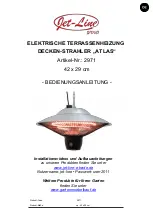
TM081 Rheem 834 Series Hydroelectric CFGWH Service Instructions
REV: AA Issued: 22/02/17
This document is stored and maintained electronically by Rheem Technical Support. All printed copies are deemed uncontrolled.
16
COMPONENTS AND THEIR FUNCTION
Gas Inlet Connection:
The gas inlet connection provides a gas connection point for the
heater.
Cold Water Inlet Connection:
The cold water inlet connection provides a cold water inlet
connection point for the heater and has a strainer to prevent foreign matter from entering
the water heater.
Hot water Outlet Connection:
The hot water outlet connection provides a hot water outlet
connection point for the heater.
Seasonal Adjustment Valve:
A manually adjustable valve
located at the cold water inlet that provides the customer with
the option of reducing the water flow rate through the heater in
colder weather to avoid insufficient heating. When in the
summer position the valve lever points down (valve fully open).
Hydroelectric Generator / Water Flow Sensor Assembly:
The hydroelectric generator is
an electromechanical device that generates an extra low voltage (1.1 ~ 1.7 VDC) when
there is water flow through the heater. The voltage generated is proportionate to the water
flow rate and is utilised to power the control circuit and recharge the battery. The water
flow sensor is an electromechanical device that sends a pulse signal to the temperature
controller that is also proportionate to the water flow rate through the heater. The
temperature controller uses the pulse signal to determine if there is sufficient water flow for
heater operation (> 3 L/m).
Water Throttle Valve:
A normally open electromagnetic valve designed to restrict the
water flow rate through the heater during a cold start. Also refer to 'Cold Start Function' on
page 12.
Pressure Relief Valve:
A spring loaded valve responsive to water pressure installed at
the hot water outlet of the water heater to protect the water heater from over pressure
damage.
Temperature Controller:
An electronic device that monitors and controls the water
temperature by energising and de-energising the gas valve solenoids and driving the
MASV up or down to increase or decrease the flow of gas to the main burner. Also refer to
'Temperature Controller' on page 18.
Ignition Module:
An electronic device that provides a pulsed high voltage to the ignition
rod to create a spark for pilot ignition. The ignition module also proves and supervises the
pilot and burner flame via the flame sensor. Also refer to 'Ignition Module' on page 19.
Ignition Rod:
An electrical device that when energised with a high voltage from the
ignition module creates a spark to earth via the pilot hood that is utilised to ignite the pilot
gas during the ignition period.
Flame Sensor:
An electrical device that projects across the flame area of the pilot and
main burner that is utilised to prove and supervise pilot and main burner flame using flame
rectification principles. Also refer to 'Ignition Module Flame Rectification Operation' on
page 12.
















































